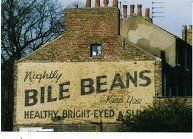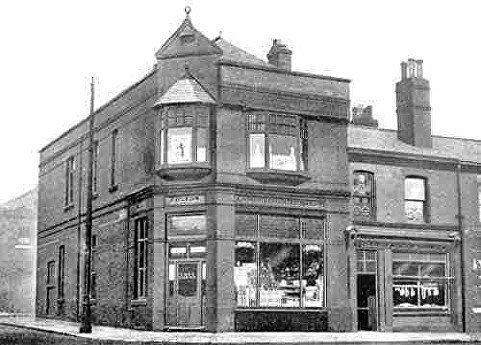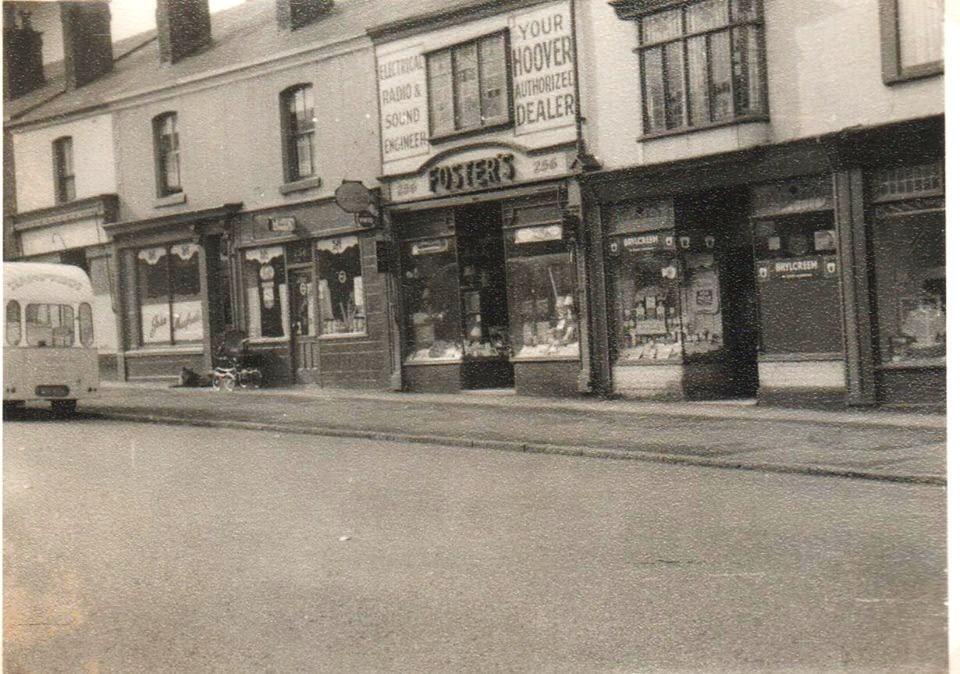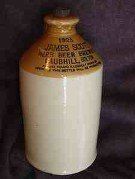In the 1960s, missing the last bus from Howell Croft South up to Daubhill Station gave opportunities to study Derby Street and St Helens Road. This road was unusual, perhaps almost unique, in that for well over a mile, almost every frontage was a shop. In the blocks of terraces off the road there were the legendary “corner shops” (in fact often in the middle of a block not actually on the corner) but there were relatively few of these because of the shops “on Dobble”. It was also remarkable in the number of pubs. On these nightly walks I counted nineteen on that mile and a half stretch (the so-called "Dobble Mile") and knew most of their names, though I had only ever been in one, run by my Uncle. Most are now demolished and the closure of Oddfellows in 2021 left only the Derby Arms open, and that a shadow of its former self.
In the 1970s it had an excess of second-hand shops, junk shops really, and since 2000 has rivalled Manchester’s “Curry Mile” in the number of eateries and cooked food outlets of every description and ethnic variety. It had always of course had its share of fish and chip shops.
Daubhill itself had the reputation that you could get anything from its shops and people came from other parts of the town for that reason. Right at the cross roads you had Yates’ newsagents on one corner and Gregory’s newsagents opposite next door to Sewell’s ironmongers (with all the usual simple tools, nails, putty etc, and paraffin, film processing and the recharging of accumulators for your radio) and Hampson’s bread shop. There was a butchers, Frank Grimshaw’s, on the corner of Morris Green, then a decorator’s shop and opposite, Devalle’s bread and cake shop, Worswick’s greengrocers, Mrs Bates’ sewing and haberdashery, and the “stores”, that is the Co-op, on the corner of Woodbine Road with a hairdressers and a sweet shop just higher and Ridyards fish and chip, Bert Entwistle's greengrocers (fish on Fridays) and Belshaw's Temperance Bar in the next block.
On the south side of St Helens Road immediately next to the railway was Timothy Whites and Taylors chemist (previously Waller and Riley) which for many years had a painted advertisement on the end wall for “Bile Beans” though this was later replaced by “National Health Service Dispensing”. (The sign pictured is actually in York and has been restored as "industrial heritage". The Daubhill one was rather less ornate.)
That block also had Marion Russell’s opticians, the Post Office (after it moved from the block below Bella Street on the other side of the road), Ken Charlson’s bike shop (now Geoff Smiths, expanded next door into the Post Office premises when that moved into the Spar shop), there was Harry Eccles’ Temperance Bar (his son Owen Eccles had a stall on Ashburner Street market), a barber's shop, Lomax’s greengrocers and the famous E P Lees radio and electrical goods shop.
Up to the 1950s Miss Boyce had a pet shop on the corner of Bella Street, what a loss that was when it was demolished, nowhere for the lads to buy “pigeon peas” for their pea-shooters! Only two hundred yards further down was Walsh’s huge plumbing shop, Dearden’s wood shop and a dress shop. On the corner of Croston Street was a co-op, Branch No 3 (now Bet Fred), with a butchery next door and across the road the Co-operative boot and shoe shop with its rounded windows.
HELP - I cannot find pictures of the block with Miss Boyce's shop, Mr Lathom's post office and the set-back cottages with long gardens and flag-stone walls.
Immediately up from Daubhill Station was Yates’ paper shop, Kemp’s barbers and Manfredi’s ice-cream parlour. This was the local coffee bar with tables and seats and a juke-box. The ice-cream parlour shut long ago but Manfredi’s still trades as wholesale ice-cream suppliers (was on Deane Church Lane) and has a couple of ice-cream vans. Deen (sic) Islamic Education Centre has been there since around 2019 - Manfredi's appears to operate from Cannon Street now.
Picture from Gene Watts
Scott’s pop factory had its main office door on the back street behind Ridyard’s and the Temperance Bar. Although it supplied glass bottles as well, its main sales in the 1940s and 50s perhaps 60s, were its own make of lemonade, sarsaparilla (sasperella), dandelion and burdock and others in stoneware jars. It had its own lorries with specially made racks on the back to carry these. In those days when hot water bottles were more often stoneware than rubber these bottles made a very acceptable substitute, even if it meant for-going your sixpence or shilling deposit on the bottle it was cheaper than four and six (or whatever) for a proper one. Outside the bottom corner of Scott’s yard was a convenient space to play cricket with wickets
chalked on a garage door (the owner was not pleased and sometimes chased us off.) The ball went over Scott’s wall so often there had to be a special “six and out” rule. It was no problem of course for a ten-year-old lad to scale the five foot wall to retrieve the ball.
There was a similar but smaller pop factory (Deakin’s) on Haynes Street with its yard at the top of Earnshaw Street.
[[Stantons was elsewhere in Bolton moving into Mossfield Mill, Vernon Street and later becoming Corona. Another pop firm, Eckersley's? was in a mill at the bottom of Cannon Street.]]
The inhabitants of Dobble were a friendly bunch who mostly knew each other and regarded Daubhill as a community in its own right. This was seen especially on New Year’s Eve when a large group would gather and would form a circle round the middle of the crossroads, hold hands and sing “Auld Lang Syne”. Who cared if some late traffic was held up for five minutes? The drivers could get out and join the fun.
For those who could not have their fun or do all their shopping up Dobble there were good bus services. As well as petrol engine buses on the Leigh route there were the trolley buses which whisked you silently down the hill into town and then back up from Howell Croft South bus station. (Pictures on pages "1878" and "1893")
The number 17 just came up as far as Daubhill, the 57 went up to Morris Green and the 48 turned from St Helens Road, up Church Avenue, Willows Lane, Kirkebrok Road and Hulton Lane to Hulton Lane Hospital (thanks to F D Orrell for a reminder). We also had the number 12 from Thynne Street which took the longer route to Manchester via Morris Green, Little Hulton, Walkden and Roe Green.
It was unusual to use the train between Daubhill Station and town because trains were much less frequent and the journey was slightly more expensive. However one day in the year before the station closed, an exceptionally thick fog (and we got two or three really bad ones every winter in those days) stopped all the buses. My mother with me aged eight in tow found her way from Thynne Street to Great Moor Street Station where we caught the train for the one stop up to Daubhill, quite an adventure!
1950s - Community
There was a sense of unity – almost everyone was from the same sort of background – the men-folk were weavers or spinners, miners, blue-collar engineers – there were foundries and engineering works in many places in Bolton and surprisingly many travelled from Daubhill to De Havilland’s at Lostock – a few had slightly more exotic sounding jobs like in the brickworks, the rope works or Charnley’s pickle factory (was there also a sack manufacturer’s on Prescott Street?). My uncle was even more exotic as a commercial traveller with the only car and the only telephone in the district. Women also worked in the cotton mills and to a small extent at all the places the men worked or in the many shops “on Dobble”, until they had children and then it was generally true that mother stayed at home looking after the children and housekeeping for the family, at least until the children were at school and could be trusted with a key hung round their necks or trusted to go from school to grandma’s or to Aunty Nelly’s until Mum arrived home from her job. But Dobble was certainly not unique in this respect.
The sense of community was perhaps to some extent a continuation from having come through the hardships of the war together. There was a sense of pride seen in the immaculate state of the net curtains in the windows and the donkey–stoned steps and the flag in front of the front door. The rag bone (rag and bone) man came round every week or so collecting recyclable waste in the form of rags, glass and scrap iron and if you gave him enough he would give you a free donkey stone – white or cream as you chose. There might well be a number of weeks without anything to give the rag and bone man – in those days you wore clothes until they practically fell off your back, then you could use the best of the material to patch other clothes, save the buttons, and use the rest for mop-rags. Then you would end up without a donkey-stone but you could always buy one from the ironmongers.
Clogs and shawls the archetypal picture of Lancashire towns up to the first world war had all but died out by the 1950s. Just one elderly lady was regularly to be seen "on Dobble" in her "widow's weeds" (think of later pictures of Queen Victoria after the death of Albert) and her shawl and clogs. Just a few men still regularly wore clogs especially in certain occupations like working on the fish market with its continually wet floor. There was a clogger's shop on Willows Lane up to about 1960. A cobbler worked out of a shed at the corner of Kirkebrok Road and Deane Church Lane. Most shoes had leather soles and if you wanted the best possible cobbling job on your shoes you had to ask for "Dri-ped Oak" made at Walkers Tannery at Rose Hill Bolton (having moved from an earlier factory in the Town Centre on the side of the River Croal near Bark Street). But most families had a cobbler's last and most men did a bit of cobbling from time to time. The machines in the cotton mills were driven from a single large steam engine by a series of leather belts. These broke from time to time and each factory had a man whose job was to mend the belts. But eventually the belts were beyond repair and were thrown out - not onto the scrap heap however, bits were taken home and used to mend shoes! Amateur cobblers seldom bought leather - if you could not get a freebie (my Dad had a mate who worked at Walkers) you could always use bits of old bicycle tyres (and he did that too).
True Lancashire dialect was spoken widely up to the 1960s, in some ways a fossilised form of 16th Century English with its “thee-s” and “thou-s” though with a local pronunciation of “thi” and “tha”, “getten” as a past participle of “get” and its flat vowels. A particular vowel sound, the “ou” in “out” was and still is local to Bolton. In Dobble but not in some other parts of Bolton, is the use of the word “moggie” for “mouse” and even “moggie meight (meat, ie food)” for “cheese". This is much more sensible than “moggie” for “cat” over most of the country – which is suggested to be short for “moggie catcher”. Another phenomenon characteristic of, though not quite unique to Bolton (and Dobble in particular) was the pronunciation of present participles, especially ending in –ting and –ping. “Chatting” becomes cha – [stop] – ttin’ with heavy emphasis on tt. The [stop] is sudden, not at all tailing off.
In the 1950s there was, as I remember, just one black man living somewhere in the Morris Green area; he was so rare that children used to turn and watch him as he walked by. Peter Burgess tells me that the black gentleman was called Ray Tomlinson and was married to his cousin, Doris Edge who lived in St Bedes Avenue along with his aunt and uncle. At times some of the West Indies cricket team had been known to stay at their house. She's still alive but lives in Abergavenny now (written around 2010). Gary Sobers was one of their guests.
Bolton has long had a community of Ukrainians and Poles the latter particularly since WWII but the only one I came into contact with was a Polish lady called Paula for whom my mother worked as a seamstress for 1/6 an hour. After my mother left her and as hand-sewing was less in demand Paula opened up as a hairdresser.
Quite far down Derby Street there had been, for as long as anyone could remember, a Chinese laundry called Dong Toy. From the sixties one or two chip shops were taken over by Chinese proprietors and through this decade Chinese food became fashionable though I do not remember a Chinese take-away up Dobble quite so long ago.
By the seventies, and it seemed to happen quite suddenly, perhaps it was more gradual but we just didn’t notice it, Daubhill developed a large Asian community. Bolton as a whole is now just over 25% non-white and the area around the border of Daubhill and Derby ward has a majority of Asians. The Pakistanis came because there were jobs going in the cotton industry for some years before its final shrinkage and demise and in public transport, but they soon moved into taxi driving and running their own businesses – almost every newsagent and off-licence is now run by Asians. As churches have closed down or at least shrunk and struggled to survive mosques have opened and thrived. There is also one large Hindu Temple in Daubhill (Adelaide Street, on the site of what I remember as the Labour Club) and one in Deane (on Deane Road near the bottom of Cannon Street, an ex-church).
Relationships between the traditional white population and the ethnic Asians are excellent. Although inevitably the communities remain separate in many ways people hold “inter-racial” conversations all the time and as far as most of the whites are concerned, a neighbour is a neighbour whether white, black, brown, yellow or green. We have third generation Asians now and although one grows used to it, it can still be a shock sometimes to hear a young Pakistani boy or girl speak with a broader Lancashire accent than any of my own friends ever did.
This area has been government designated as a destination for immigrants and refugees and since around 2000 we have had a considerable number of Eastern Europeans; if you shop at Lidl almost the last language you will hear is English! More recently we have seen the arrival of a large number of Africans mostly from Nigeria and eSwatini (Swaziland).
The next page is a miscellany of items sent to this web-site by readers.




